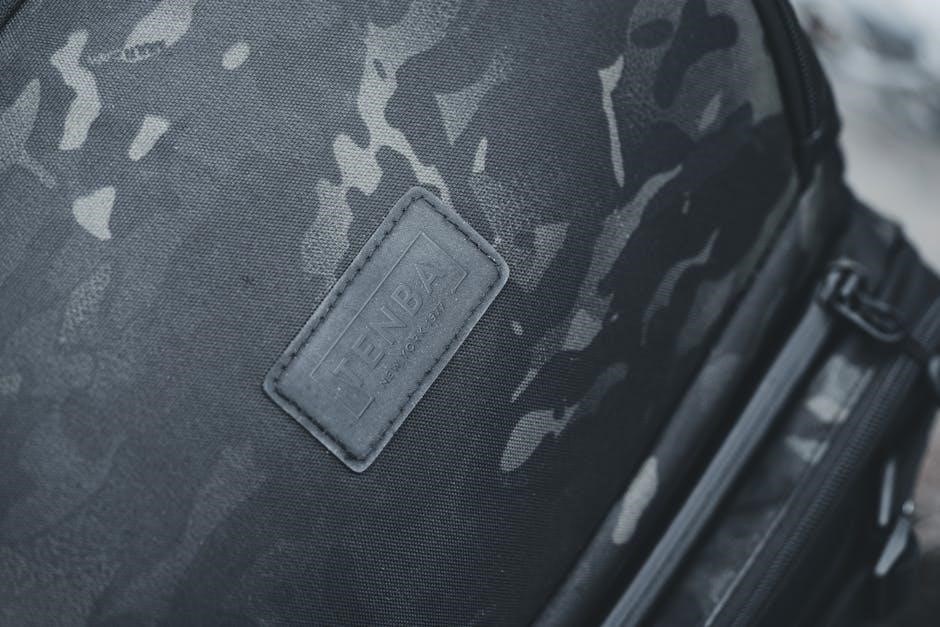The Mockins Cargo Carrier is a durable, rust-proof hitch-mounted solution designed to transport up to 500 lbs of cargo, ideal for outdoor enthusiasts and travelers seeking efficient storage solutions.
1.1 Overview of the Mockins Cargo Carrier
The Mockins Cargo Carrier is a heavy-duty, rust-proof steel hitch-mounted rack designed for durability and versatility. With a 500 lbs capacity, it’s ideal for transporting luggage, camping gear, or equipment, keeping your vehicle’s interior free. Featuring a waterproof cargo bag, anti-rattle device, and folding design, it offers convenience and reliability. Constructed from heavy-duty steel, it ensures long-lasting performance and withstands various weather conditions.
1.2 Importance of Proper Instructions
Proper instructions are essential for the safe and effective use of the Mockins Cargo Carrier. Following the guidelines ensures the carrier is assembled and installed correctly, preventing potential damage or safety hazards. The instructions provide critical information on weight limits, assembly steps, and maintenance tips, helping users maximize the carrier’s performance and longevity. Adhering to the manual also ensures compliance with safety standards, reducing the risk of accidents during transportation. By understanding and following the instructions, users can achieve optimal functionality and durability of their Mockins Cargo Carrier.
Features of the Mockins Cargo Carrier
The Mockins Cargo Carrier offers a heavy-duty construction, waterproof cargo bag, anti-rattle device, folding design, and ratchet straps for secure and efficient load transportation.
2.1 Heavy-Duty Construction
The Mockins Cargo Carrier is built with durable, heavy-duty materials to ensure long-lasting performance and reliability. Its robust steel frame is designed to withstand heavy loads and harsh weather conditions, making it ideal for frequent use. The construction is rust-resistant, ensuring durability over time. This sturdy build allows the carrier to handle up to 500 lbs of weight securely, providing peace of mind during transport. The heavy-duty design also minimizes wobbling and ensures stability, contributing to a safer and more efficient hauling experience. This makes it a reliable choice for both small and large cargo needs.
2.2 Waterproof Cargo Bag
The Mockins Cargo Carrier includes a high-quality, waterproof cargo bag designed to protect your belongings from rain, snow, and dust. Made from durable, tear-resistant material, the bag ensures your items remain dry and secure during transit. Its large capacity accommodates various sizes of luggage, tools, or equipment. The bag features multiple straps for easy attachment and removal, while its reinforced seams provide added strength. This waterproof feature is essential for outdoor enthusiasts and travelers, ensuring your cargo stays safe and dry regardless of weather conditions. It’s a practical solution for all-weather hauling needs.
2.3 Anti-Rattle Device
The Mockins Cargo Carrier features an anti-rattle device designed to minimize noise and vibrations during travel. This mechanism ensures a smooth and quiet towing experience by securely locking the carrier in place, eliminating any movement that could cause rattling. Made from durable materials, it withstands various road conditions while maintaining stability. The anti-rattle device is easy to install and adjust, offering a hassle-free solution to common towing issues. This feature enhances overall safety and comfort, making it ideal for long trips or uneven terrain. Its robust construction ensures long-lasting performance and reliability for years of trouble-free use.
2.4 Folding Design
The Mockins Cargo Carrier boasts a convenient folding design, allowing for easy storage when not in use. This feature is perfect for those with limited space, as it can be compactly folded and stored in a garage, trunk, or even under a bed. The durable, heavy-duty frame maintains its structural integrity while folded, ensuring long-term reliability. Users can effortlessly fold and unfold the carrier, making it a practical solution for both small and large vehicles. This space-saving feature enhances portability and versatility, ensuring the carrier remains a valuable accessory for any trip or storage need.
2.5 Ratchet Straps and Hitch Stabilizer
The Mockins Cargo Carrier includes heavy-duty ratchet straps and a hitch stabilizer for secure and stable cargo transport. The ratchet straps, typically 1″ or 2″ wide, provide a snug fit and ensure your load remains tightly fastened. The hitch stabilizer minimizes wobbling and noise during driving, enhancing safety and reducing wear on the carrier. Designed to work seamlessly with the hitch receiver, these components ensure a stable connection to your vehicle. Together, they offer a reliable solution for transporting heavy loads, providing peace of mind on long or short trips. This feature-rich design makes the Mockins Cargo Carrier a standout choice for durability and security.
Understanding Capacity and Weight Limits
Knowing the Mockins Cargo Carrier’s weight capacity and size ensures safe and efficient load transport, preventing damage and ensuring stability during travel.
3.1 Weight Capacity of 500 lbs

The Mockins Cargo Carrier is designed to hold a maximum weight of 500 lbs, ensuring durability and stability for various cargo needs. This capacity includes both the carrier and its contents, making it ideal for hauling bulky items securely. Exceeding this limit can compromise safety and damage the carrier. Always distribute weight evenly and verify your vehicle’s hitch rating to avoid overloading. Proper loading ensures optimal performance and prevents potential hazards during transport. Adhering to the weight limit guarantees reliable use and extends the product’s lifespan, making it a practical solution for outdoor adventures or daily errands.
3.2 Size and Dimensions
The Mockins Cargo Carrier is designed with practical size and dimensions to accommodate various cargo needs. Measuring approximately 60″ x 24″ x 6″, it provides ample space for luggage, tools, or sports gear. When folded, it reduces to 42″ x 24″ x 6″, making it easy to store in tight spaces. The carrier’s compact yet spacious design ensures it fits most vehicle hitches without obstructing rear access. Its dimensions are optimized for versatility, allowing users to transport bulky items securely while maintaining vehicle maneuverability. Always check the carrier’s size against your vehicle’s hitch and storage capabilities for the best fit.
3.3 Choosing the Right Carrier
Selecting the right cargo carrier involves assessing your specific needs and vehicle compatibility. Consider the type of items you’ll transport, as well as your vehicle’s hitch size and weight capacity. The Mockins Cargo Carrier is ideal for SUVs, trucks, and cars with a 2-inch hitch receiver. Ensure the carrier’s size and weight limits align with your typical cargo load. For heavy-duty use, prioritize sturdy construction and durable materials. Additionally, consider features like foldability, waterproofing, and ease of assembly to maximize convenience and usability. Always verify compatibility with your vehicle to ensure safe and optimal performance.

Step-by-Step Assembly Instructions

Begin by unpacking and organizing all components. Follow the manual to identify each part. Attach accessories like the cargo bag and anti-rattle device. Align the frame properly, then tighten all bolts securely. Double-check every connection for stability. Ensure all parts are firmly locked in place before use. This straightforward process ensures a stress-free assembly experience, providing a durable and reliable cargo carrier for your needs.
4.1 Unpacking and Organizing Components
Start by carefully unboxing the Mockins Cargo Carrier and inspecting all parts for damage. Organize the components, such as the frame, brackets, straps, and hardware, in a clean workspace. Refer to the instruction manual to identify each item. Separate bolts, nuts, and smaller parts into labeled containers to avoid misplacement. Ensure all tools, like wrenches and screwdrivers, are within reach. Lay out the cargo bag and accessories alongside the main frame for easy access. This systematic approach ensures a smooth assembly process and prevents missing or misplaced parts. Proper organization is key to a hassle-free setup.
4.2 Assembling the Frame
Begin by attaching the side rails to the base of the Mockins Cargo Carrier using the provided bolts and nuts. Ensure all connections are secure and tighten them firmly. Next, connect the crossbars to the side rails, forming the frame’s structure. Use an Allen wrench to tighten these bolts. Align the frame carefully to ensure stability and even weight distribution. Double-check that all joints are tightly secured to prevent any movement during use. Finally, attach the hitch adapter to the frame, making sure it is properly aligned and secured. This forms the foundation for the entire carrier system.
4.3 Attaching Accessories
After assembling the frame, attach the cargo bag by securing it to the carrier using the provided straps. Tighten the straps evenly to ensure the bag is firmly in place. Next, install the anti-rattle device to the frame to minimize noise during travel. Attach any additional accessories, such as the hitch stabilizer, to enhance stability. Ensure all components are tightly fastened and properly aligned. Double-check that all straps and accessories are snug and secure to prevent movement while driving. This step ensures your Mockins Cargo Carrier is fully equipped and ready for use.
4.4 Aligning and Tightening
Once the frame and accessories are assembled, align the carrier to ensure it is straight and evenly balanced. Use the hitch pin to secure the carrier to your vehicle’s hitch receiver. Tighten all bolts and screws firmly, following the torque specifications in the manual. Check the frame alignment to ensure it is level and properly seated. Tighten the anti-rattle device to minimize movement and noise. Double-check all connections and straps to ensure they are snug and evenly tightened. Proper alignment and tightening are crucial for safe and stable transportation of your cargo.

Installation Guide
Ensure proper hitch compatibility and follow step-by-step mounting instructions. Secure the carrier tightly and verify all connections for stability. Always adhere to safety guidelines for a secure setup.
5.1 Hitch Compatibility
The Mockins Cargo Carrier is designed to fit standard 2-inch hitch receivers, ensuring compatibility with most vehicles. Before installation, verify your vehicle’s hitch type and class rating to ensure proper fitment. Class III or IV hitches are recommended for optimal performance. Clean the hitch receiver to remove dirt or rust, which could interfere with the carrier’s stability. Always check the vehicle’s manual for specific hitch specifications and weight limits. Proper hitch alignment is crucial for safe and secure installation, preventing any wobbling or noise during transit.
5.2 Mounting the Carrier
To mount the Mockins Cargo Carrier, lift it carefully and align the hitch pin with the receiver. Ensure the carrier is centered and fully seated. Insert the hitch pin or bolt through the receiver and carrier holes, securing it tightly. Tighten all bolts firmly using a wrench or socket. Double-check alignment to avoid wobbling. For heavier loads, consider using a stabilizer to enhance stability. Always torque bolts to the manufacturer’s specifications to ensure a safe and secure connection. Have a second person assist if needed to prevent accidents during installation.
5.3 Securing the Carrier
Securing the Mockins Cargo Carrier is crucial for safe transport. Use ratchet straps to tie down cargo evenly, preventing shifting during transit. Tighten all straps firmly and engage the hitch stabilizer to minimize movement. Ensure the cargo bag is properly attached and all zippers are securely closed. Double-check all connections and straps for tightness. Follow the manufacturer’s guidelines for securing loads. After driving a few miles, stop to check and tighten the straps again if necessary. This ensures your cargo remains safe throughout your journey.
5.4 Checking for Proper Fit
After mounting, ensure the Mockins Cargo Carrier fits securely on your vehicle. Visually inspect the connection to confirm there are no gaps or misalignments. Gently tug the carrier to verify stability and check for any wobbling. Make sure the carrier is level and evenly positioned. Inspect all bolts, straps, and attachments for proper tightness. Ensure the cargo area is clear of obstructions and the carrier does not interfere with vehicle functions like brakes or suspension. Proper fit ensures safety and prevents damage to both the carrier and your vehicle during transit.
Safety Precautions and Guidelines
Always wear safety gloves when handling the carrier. Ensure the load is evenly distributed and secured tightly. Never exceed the recommended weight capacity. Be cautious while driving, as the added weight may affect vehicle handling. Regularly inspect the carrier and straps for wear and tear.
6.1 Pre-Installation Checks
Before installing the Mockins Cargo Carrier, ensure your vehicle’s hitch is clean and free of debris. Inspect the hitch receiver for damage or rust. Verify that the carrier’s bolts and nuts are tightened properly. Check the hitch pin size to ensure compatibility with your vehicle’s receiver. Measure the hitch height to confirm it aligns with the cargo carrier. Ensure the vehicle is parked on level ground to avoid uneven installation. Always refer to your vehicle’s manual for specific guidelines. Proper preparation ensures a safe and secure installation process.
6.2 Loading Best Practices
To ensure safe and efficient use of the Mockins Cargo Carrier, follow these loading best practices. Always distribute the weight evenly across the carrier to avoid imbalance. Place heavier items closer to the vehicle and lighter ones toward the outer edges. Use the provided cargo bag to keep items secure and protected from the elements. Ensure all loads are tightly strapped down with the ratchet straps to prevent shifting during transit. Avoid overloading beyond the recommended 500 lbs capacity. Double-check that the cargo does not obstruct your vehicle’s taillights or license plate. Proper loading ensures stability and safety on the road.
6.3 Securing Loads
Properly securing loads on the Mockins Cargo Carrier is essential for safe transport. Use the included ratchet straps to tightly fasten items, ensuring they cannot shift during movement. Tighten straps evenly and avoid over-tightening, which could damage the cargo or carrier. Engage the anti-rattle device to minimize noise and movement. Check all straps and connections before driving to ensure everything is secure. For added protection, place items inside the waterproof cargo bag and close it tightly. Always double-check that the load is balanced and evenly distributed to maintain stability while driving.
6.4 Driving Safely
When driving with the Mockins Cargo Carrier, always prioritize safety. Adjust your driving habits to account for the added weight and potential shift in your vehicle’s center of gravity. Avoid sudden acceleration, sharp turns, or hard braking, as these can destabilize the load. Keep a safe distance from other vehicles and be mindful of changing weather conditions. Regularly check your rearview and side mirrors to monitor the carrier and cargo. Ensure the carrier is properly secured before starting your journey and maintain a moderate speed to reduce the risk of accidents.

Maintenance and Care Tips
Regularly wash the carrier with mild soap and water; Apply lubricant to moving parts. Store in a dry place to prevent rust. Ensure durability.
7.1 Cleaning the Carrier

Regular cleaning is essential to maintain the Mockins Cargo Carrier’s durability. Use mild soap and water to wipe down the frame and accessories. Avoid harsh chemicals or abrasive materials that could damage the finish. Rinse thoroughly with clean water to remove soap residue. For the cargo bag, hose it down, then scrub gently with a soft-bristle brush. Allow both the carrier and bag to air dry completely to prevent water spots. Clean after each use to remove dirt and debris, ensuring optimal performance and longevity. Regular maintenance helps preserve the carrier’s condition and functionality over time.
7.2 Rust Prevention
Rust prevention is crucial for maintaining the durability of your Mockins Cargo Carrier. Regularly inspect for signs of rust and address them immediately. Clean the carrier thoroughly before applying a rust-inhibiting spray or coating. Ensure all metal surfaces are dry before storage or use. Apply a clear protective wax or sealant to exposed areas for added protection. Store the carrier in a dry, well-ventilated space when not in use. Touch up any scratches or chipped paint promptly to prevent rust from forming. Regular maintenance will help extend the life of your cargo carrier and keep it in excellent condition.
7.3 Storage Tips
Proper storage of your Mockins Cargo Carrier ensures long-term durability and functionality. Clean the carrier thoroughly before storage to remove dirt and moisture. Store it in a dry, well-ventilated area away from direct sunlight to prevent UV damage. Avoid leaving it exposed to extreme temperatures or humidity. Consider using a breathable cover to protect it from dust. If possible, store the carrier in its original packaging or a sturdy box. Keep it off the ground to prevent moisture accumulation. Regularly inspect stored items for signs of wear or damage. Proper storage will maintain your carrier’s condition and readiness for future use.
7.4 Lubricating Moving Parts
Lubricating the moving parts of your Mockins Cargo Carrier is essential for smooth operation and longevity. Use a silicone-based lubricant on hinges, joints, and any other moving components. Apply the lubricant after assembly and every 1-2 months, depending on usage. Avoid over-lubrication, as it may attract dust and dirt. Wipe off excess lubricant with a clean cloth. Regular lubrication prevents rust and ensures the carrier folds and unfolds effortlessly. This maintenance step is crucial for maintaining the durability and performance of your cargo carrier. Always refer to the manual for specific lubrication points recommended by the manufacturer.

Troubleshooting Common Issues
Identify and address common issues like wobbling, noise, or damaged parts. Check for loose connections, bent frames, or worn-out straps. Tighten bolts, replace damaged components, and ensure proper alignment. Refer to the manual for specific solutions or contact customer support for assistance. Regular inspections can prevent major problems and ensure safe use of the cargo carrier.
8.1 Wobble and Noise
Wobble and noise are common issues that may arise during use. Check for loose bolts or misaligned frames, as these can cause instability. Tighten all connections firmly and ensure the carrier is properly attached to the hitch. If noise persists, inspect for worn-out or damaged parts, such as the anti-rattle device or rubber pads. Replace any damaged components and lubricate moving parts to reduce friction. Ensure the carrier is evenly loaded and aligned with the vehicle’s hitch to minimize wobble. Regular inspections and adjustments can help prevent these issues and ensure smooth operation.
8.2 Bent or Damaged Parts
If parts of your Mockins Cargo Carrier are bent or damaged, inspect the affected area carefully. Minor bends may be straightened with tools, but severely damaged parts require replacement. Contact customer support for genuine replacement components. Avoid using the carrier until repairs are made, as this could compromise safety. Regular inspections and proper handling can prevent damage. Store the carrier in a dry place to avoid rust and ensure longevity. Always follow the manufacturer’s guidelines for repair and replacement to maintain the product’s durability and performance.
8.3 Straps and Bag Issues
Straps and the cargo bag are critical components of the Mockins Cargo Carrier. If straps become frayed or damaged, replace them immediately to ensure secure loading. For holes or tears in the bag, patch them with waterproof material or contact Mockins for a replacement. If straps frequently come loose, check the buckles and tighten them properly. Regularly inspect the bag for wear and tear, especially at seams. Clean straps and buckles to prevent dirt buildup. Always follow the manufacturer’s recommendations for strap replacement and bag maintenance to ensure safe and reliable performance.
8.4 Repair Options

If your Mockins Cargo Carrier is damaged, assess the issue first. For minor damage, such as bent parts or loose connections, tighten bolts or straighten components carefully. Replace severely damaged parts using genuine Mockins replacement kits. Contact customer support for assistance with complex repairs or warranty claims. Regular maintenance, like lubricating hinges and inspecting straps, can prevent major issues. Store the carrier properly when not in use to avoid unnecessary wear. Always follow the manufacturer’s repair guidelines to ensure safety and longevity of the product.
8.5 Customer Support
Mockins offers reliable customer support to address any questions or concerns about the cargo carrier. Contact their support team via phone, email, or live chat for assistance with troubleshooting, repairs, or replacement parts. They are available Monday through Friday, 9 AM to 5 PM EST. For faster service, have your order number and product details ready. Mockins also provides online resources, including FAQs and user manuals, to help resolve common issues. Their dedicated team ensures prompt and effective solutions to keep your cargo carrier functioning optimally.
Mockins Cargo Carrier offers durability, versatility, and ease of use, making it an excellent choice for transporting gear. Follow instructions carefully for optimal performance and safety.
9.1 Summary of Key Points

The Mockins Cargo Carrier is a durable, versatile solution for transporting gear. It features a heavy-duty frame, waterproof bag, and anti-rattle device for secure, quiet operation. Proper assembly, installation, and loading are crucial for safety and performance. Always follow weight limits and ensure the carrier is securely mounted to your vehicle. Regular maintenance, such as cleaning and lubricating moving parts, will extend its lifespan. Troubleshooting common issues like wobble or strap damage can be done with basic tools and repairs. Adhere to the instructions for reliable performance and safe transportation of your cargo.
9.2 Final Tips for Optimal Use
For optimal use of the Mockins Cargo Carrier, always load items evenly and secure them tightly with ratchet straps. Regularly inspect the carrier and attachments for wear and tear, ensuring all bolts are tightened properly before each trip; Keep the carrier clean and dry to prevent rust and extend its lifespan. Drive cautiously, especially on uneven roads, and never exceed the weight capacity. Refer to the user manual for specific guidelines and store the carrier in a dry place when not in use to maintain its condition and functionality.










